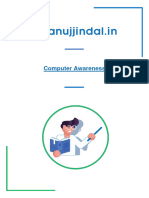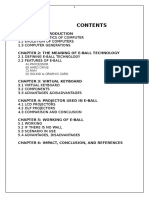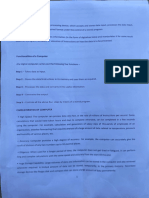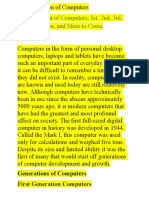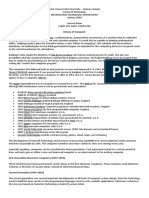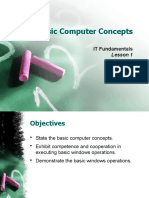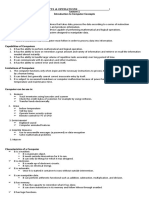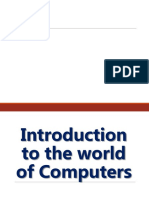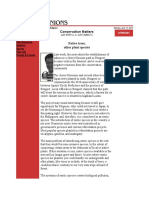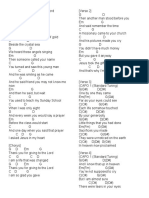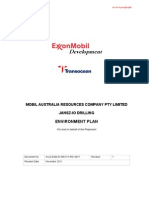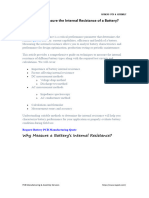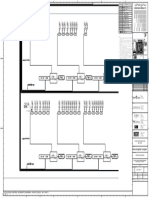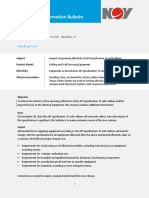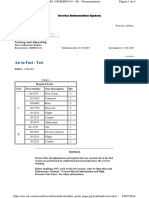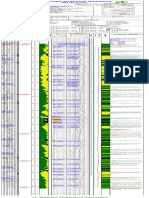Chapter 1
Basic Introduction to Computers
Discovering
Computers 2012
Your Interactive Guide
to the Digital World
�Objectives Overview
See Page 3
for Detailed Objectives
Discovering Computers 2012: Chapter 1
�Objectives Overview
See Page 3
for Detailed Objectives
Discovering Computers 2012: Chapter 1
�A World of Computers
Computers are everywhere
Pages 4 - 5
Figure 1-1
Discovering Computers 2012: Chapter 1
�What Is a Computer?
A computer is an electronic device,
operating under the control of
instructions stored in its own memory
Information Processing Cycle
Page 6
Discovering Computers 2012: Chapter 1
�What Is a Computer?
Page 6
Figure 1-2
Discovering Computers 2012: Chapter 1
�Computer
7
�Computer
a general-purpose electronic
device that accepts data as input,
processes the data according to
internal instructions (which are
executed without human
intervention), and produces
information.
�Computer
an electronic device that receives
data and instructions,
manipulates/processes the data
into information, and then
furnishes/outputs the processed
results in a form that is readable,
either by a person or another
machine or device
9
�Computers
Characteristics
It
It
It
It
It
It
is a machine
is electronic
is automatic
can manipulate data
has memory
has logic functions
10
�Computers
Capabilities
Speed
Repetitiveness
Accuracy
Store and recall information
Logical Operations
Self checking and self operating
11
�Computers
Limitations
The computer
is dependent
on the instructions and data
given
by any human being.
12
�Computers
Limitations
Cannot generate information on its
own.
Cannot correct wrong instructions
Cannot come out original
decisions
Computer application must be
quantified
13
�History of Computer
Ancient ways of counting and
computing
Human body
Objects
14
�History of Computer
Abacus
the first man-made computing device
which is made up of small stones or
pebbles or beads or shells or chicken
bones
made in China in the 12th century
15
�Abacus
16
�History of Computer
Number System (0-9)
a Hindu-Arabic influence
Napiers Bones (John Napier in 1614)
a set of eleven rods, made up of
bones and ivory, with numbers
marked on them and used to multiply,
divide and extract the square root
17
�Napiers Bones
18
�History of Computer
Oughtreds Slide Rule
by William Oughtred in 1630, consists
of two movable rulers placed side by
side; by sliding the rulers one can
quickly multiply and divide
19
�Oughtreds Slide Rule
20
�History of Computer
Pascals Adding Machine
a machine developed by Blaise Pascal
in 1642 capable of adding and
subtracting numbers; it adopted the
principle of the abacus but instead of
using the hands to move the counters,
Pascal used wheels
21
�Pascals Adding Machine
22
�History of Computer
Babbages Analytical Engine
a machine that could have been the
first computer that performs all
mathematical operations, stores
information in its memory and
performs logical operations but it
lacked electronics (electromechanical)
23
�History of Computer
Babbages Analytical Engine
invented by Charles Babbage who
was considered the father of the
modern computer
Lady Ada Byron was referred to as
the first programmer since she wrote
a demonstration program for
Babbages Analytical Engine
24
�Babbages Analytical
Engine
25
�History of Computer
Holleriths Tabulating Machine
a machine where data to be
processed where coded as holes in
cards that represent the digits and
letters which were passed on
electrical contacts that were either
turned on or of
26
�History of Computer
Holleriths Tabulating Machine
the first commercially successful data
processing machine invented by
Herman Hollerith
in 1911, the Census Bureau with its
competitor and formed the
International Business Machines (IBM)
27
�Holleriths Tabulating
Machine
28
�History of Computer
MARK I
Automatic Sequence Controlled
Calculator (ASCC) completed in 1914
by Howard Aiken
the first automatic general purpose
digital computer
29
�MARK I
30
�History of Computer
ENIAC
Electronic Numerical Integrator and
Calculator developed during the
period 1943-1946
the first large-scale vacuum tube
computer
31
�ENIAC
32
�History of Computer
EDVAC
Electronic Discrete Variable
Automatic Computer developed in
1946 by John von Neumann
stored programs
33
�EDVAC
34
�History of Computer
EDSAC
Electronic Delay Storage Automatic
Calculator developed in 1949
the first stored program machine to
go on operation
35
�EDSAC
36
�History of Computer
Kenbak -1
First Personal Computer in 1971
Uses switches for input and light for
output
256 byte memory
37
�Kenbak - 1
38
�History of Computer
Alto
First work station with built in mouse
for input in 1974
Network, menus and icon
Can store several files
39
�Alto
40
�History of Computer
Apple II
First system sold with keyboard in
1977
Television was the monitor
41
�Apple II
42
�History of Computer
Apple 2
First true Personal Computer in
1977
Color graphics (16 colors)
43
�Apple 2
44
�Computer Generations
1st Generation Computers (19511959)
vacuum tubes
2nd Generation Computers (19591964)
transistors
45
�Vacuum Tubes
46
�Transistors
47
�Computer Generations
3rd Generation Computers (1965-1970)
solid state technology and integrated
circuitry
4th and 5th Generation Computers
(1970-)
further miniaturization of circuits, increased
multiprogramming and by virtual storage
memory, time sharing, and operating
speed
48
�IC, Microchips
49
�Introduction to
Information
Technology
Classification of Computers
�Classification of
Computers
Classified according to:
Purpose
Types of data handled
Capacity
51
�According to Purpose
General-purpose Computers
designed to handle a variety of
diferent problems and to meet
diferent needs
strong in versatility but are normally
weak in speed and efficiency
52
�According to Purpose
Special-purpose Computers
designed to handle a specific problem
or to perform a specific task
inflexible and cannot be used for
tasks other than for which it is
designed
53
�According to Data
Analog Computers
deal with continuously changing
physical data such as pressure,
temperature, current; can only
provide approximate results
54
�According to Data
Digital Computers
computers that specialize in counting
55
�According to Capacity
Storage
Capacity
Speed
Microcomput 64,000 7M 64,000
er
characters
16M
characters
Minicompute 1 50 M
4 64M
r
characters
characters
60,000 1
MIPS
Main Memory
Mainframe
1-5 MIPS
32 200M
characters
Above 32M
Characters
5 MIPS
and up
Supercomput 64 M 2B
er
characters
No
Limitations
10 MIPS
and up
56
�Advantages and Disadvantages
of Using Computers
Advantages of
Using Computers
Pages 9 - 10
Disadvantages of
Using Computers
Discovering Computers 2012: Chapter 1
57
�The Components of a
Computer
A computer contains many electric, electronic,
and mechanical components known as
hardware
Pages 6 - 8
Discovering Computers 2012: Chapter 1
58
�The Components of a
Computer
Page 7
Figure 1-3
Discovering Computers 2012: Chapter 1
59
�Advantages and Disadvantages
of Using Computers
Green computing involves reducing the
electricity consumed and environmental
waste generated when using a computer
Strategies include:
Page 10
Recycling
Regulating manufacturing processes
Extending the life of computers
Immediately donating or properly disposing of replaced
computers
Discovering Computers 2012: Chapter 1
60
�Networks and the Internet
A network is a
collection of
computers and
devices connected
together, often
wirelessly, via
communications
devices and
transmission media
Pages 10 - 11
Figure 1-6
Discovering Computers 2012: Chapter 1
61
�Networks and the Internet
The Internet is a worldwide collection of
networks that connects millions of businesses,
government agencies, educational
institutions, and individuals
Page 11
Figure 1-7
Discovering Computers 2012: Chapter 1
62
�Networks and the Internet
People use the Internet for a variety of
reasons:
Pages 12 - 13
Figure 1-8
Discovering Computers 2012: Chapter 1
63
�Networks and the Internet
A social networking Web site
encourages members to share their
interests, ideas, stories, photos, music,
and videos with other registered users
Page 14
Figure 1-9
Discovering Computers 2012: Chapter 1
64
�Computer Software
Software, also called a program, tells
the computer what tasks to perform and
how to perform them
Pages 15 - 16
Figures 1-10 - 1-11
Discovering Computers 2012: Chapter 1
65
�Computer Software
Installing is the process of setting up
software to work with the computer,
printer, and other hardware
Pages 16 - 17
Figure 1-12
Discovering Computers 2012: Chapter 1
66
�Computer Software
A programmer
develops software
or writes the
instructions that
direct the
computer to
process data into
information
Page 18
Figure 1-13
Discovering Computers 2012: Chapter 1
67
�Categories of Computers
Page 19
Discovering Computers 2012: Chapter 1
68
�Personal Computers
A personal computer can perform all
of its input, processing, output, and
storage activities by itself
Two popular architectures are the PC
and the Apple
Desktop computer
Pages 19 - 20
Figures 1-15 - 1-16
Discovering Computers 2012: Chapter 1
69
�Mobile Computers and Mobile
Devices
Pages 20 - 23
Discovering Computers 2012: Chapter 1
70
�Mobile Computers and Mobile
Devices
Pages 20 - 22
Figures 1-17 1-20
Discovering Computers 2012: Chapter 1
71
�Mobile Computers and Mobile
Devices
Pages 22 - 23
Figures 1-21 1-23
Discovering Computers 2012: Chapter 1
72
�Game Consoles
A game console is
a mobile
computing device
designed for
single-player or
multiplayer video
games
Page 24
Figure 1-24
Discovering Computers 2012: Chapter 1
73
�Servers
A server controls
access to the
hardware, software,
and other resources
on a network
Provides a
centralized storage
area for programs,
data, and
information
Page 25
Figure 1-25
Discovering Computers 2012: Chapter 1
74
�Mainframes
A mainframe is a
large, expensive,
powerful computer
that can handle
hundreds or
thousands of
connected users
simultaneously
Page 25
Figure 1-26
Discovering Computers 2012: Chapter 1
75
�Businesses today rely on the
mainframe to:
Perform large-scale transaction
processing (thousands of transactions per
second)
Support thousands of users and
application programs concurrently
accessing numerous resources
Manage terabytes of information in
databases
Handle large-bandwidth communication
Discovering Computers 2012: Chapter 1
76
�Supercomputers
A supercomputer is the fastest, most
powerful computer
Fastest supercomputers are capable of
processing more than one quadrillion
instructions in a single second
Page 25
Figure 1-27
Discovering Computers 2012: Chapter 1
77
� The fastest type of computer.
Supercomputers are very expensive and are
employed for specialized applications that
require immense amounts of mathematical
calculations.
For example, weather forecasting requires a
supercomputer.
Other uses of supercomputers include animated
graphics, fluid dynamic calculations, nuclear
energy research, and petroleum exploration.
Discovering Computers 2012: Chapter 1
78
�Difference of a mainframe
and a supercomputer
A supercomputer channels all its power
into executing a few programs as fast as
possible
A mainframe uses its power to execute
many programs concurrently.
Discovering Computers 2012: Chapter 1
79
�Embedded Computers
An embedded computer is a specialpurpose computer that functions as a
component in a larger product
Page 26
Discovering Computers 2012: Chapter 1
80
�Embedded Computers
Page 26
Figure 1-28
Discovering Computers 2012: Chapter 1
81
�Elements of an Information
System
Page 27
Discovering Computers 2012: Chapter 1
82
�Elements of an Information
System
Page 27
Figure 1-29
Discovering Computers 2012: Chapter 1
83
�Computer Applications in
Society
Pages 34 - 36
Figures 1-36 1-39
Discovering Computers 2012: Chapter 1
84
�Computer Applications in
Society
Pages 36 - 38
Figures 1-40 1-43
Discovering Computers 2012: Chapter 1
85
�Summary
Page 39
Discovering Computers 2012: Chapter 1
86
�Chapter 1
Basic Introduction to Computers
Discovering
Computers 2012
Your Interactive Guide
to the Digital World
Chapter 1 Complete













